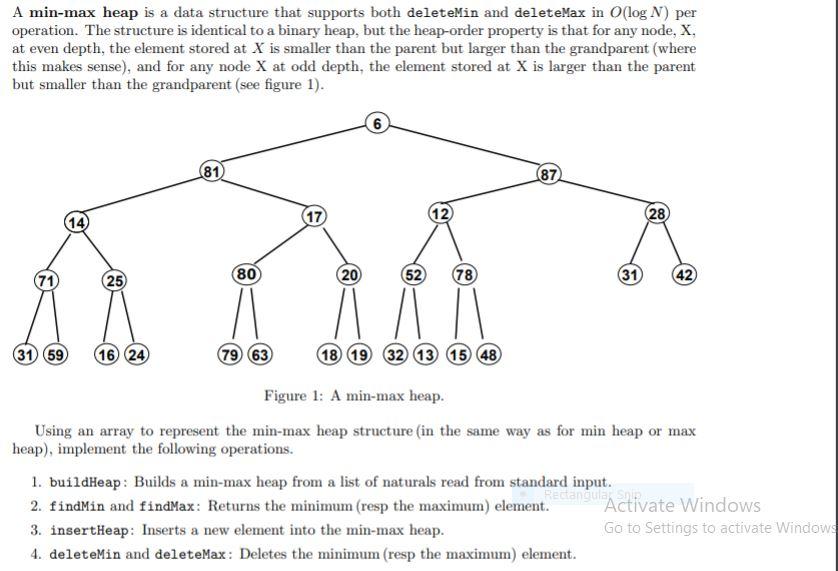Question
A min-max heap is a data structure that supports both deleteMin and deleteMax in O(log N) per operation. The structure is identical to a binary

A min-max heap is a data structure that supports both deleteMin and deleteMax in O(log N) per operation. The structure is identical to a binary heap, but the heap-order property is that for any node, X, at even depth, the element stored at X is smaller than the parent but larger than the grandparent (where this makes sense), and for any node X at odd depth, the element stored at X is larger than the parent but smaller than the grandparent (see figure 1). 6 81 87 14 17 71 80 12 25 20 52 28 78 31 42 31 59 16 24 79 63 18 19 32 13 15 48 Figure 1: A min-max heap. Using an array to represent the min-max heap structure (in the same way as for min heap or max heap), implement the following operations. 1. buildHeap : Builds a min-max heap from a list of naturals read from standard input. 2. findMin and findMax : Returns the minimum (resp the maximum) element. 3. insertHeap : Inserts a new element into the min-max heap. 4. deleteMin and deleteMax : Deletes the minimum (resp the maximum) element.
this is how our prof posted the assignment. So I really don't have any further information.
A min-max heap is a data structure that supports both deleteMin and deleteMax in O(log N) per operation. The structure is identical to a binary heap, but the heap-order property is that for any node, X, at even depth, the element stored at X is smaller than the parent but larger than the grandparent (where this makes sense), and for any node X at odd depth, the element stored at X is larger than the parent but smaller than the grandparent (see figure 1). 6 81 87 17 12 14 28 (71 25 80 20 52 78 (31 42 31 59 16 24 (79 63 18 19 32 13 15 48 Figure 1: A min-max heap. Using an array to represent the min-max heap structure in the same way as for min heap or max heap), implement the following operations. 1. buildHeap: Builds a min-max heap from a list of naturals read from standard input. Radang Si 2. findMin and findMax: Returns the minimum (resp the maximum) element. Activate Windows 3. insertHeap: Inserts a new element into the min-max heap. Go to Settings to activate Windows 4. deleteMin and deleteMax: Deletes the minimum (resp the maximum) element. A min-max heap is a data structure that supports both deleteMin and deleteMax in O(log N) per operation. The structure is identical to a binary heap, but the heap-order property is that for any node, X, at even depth, the element stored at X is smaller than the parent but larger than the grandparent (where this makes sense), and for any node X at odd depth, the element stored at X is larger than the parent but smaller than the grandparent (see figure 1). 6 81 87 17 12 14 28 (71 25 80 20 52 78 (31 42 31 59 16 24 (79 63 18 19 32 13 15 48 Figure 1: A min-max heap. Using an array to represent the min-max heap structure in the same way as for min heap or max heap), implement the following operations. 1. buildHeap: Builds a min-max heap from a list of naturals read from standard input. Radang Si 2. findMin and findMax: Returns the minimum (resp the maximum) element. Activate Windows 3. insertHeap: Inserts a new element into the min-max heap. Go to Settings to activate Windows 4. deleteMin and deleteMax: Deletes the minimum (resp the maximum) elementStep by Step Solution
There are 3 Steps involved in it
Step: 1

Get Instant Access to Expert-Tailored Solutions
See step-by-step solutions with expert insights and AI powered tools for academic success
Step: 2

Step: 3

Ace Your Homework with AI
Get the answers you need in no time with our AI-driven, step-by-step assistance
Get Started


